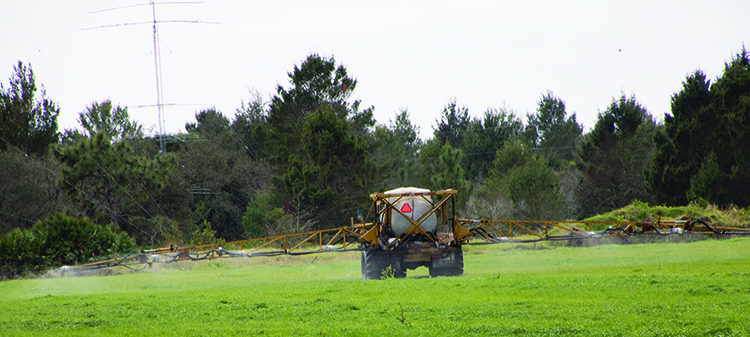Good time for a sprayer upgrade |
| By Adam Verner |
|
|
The author is a managing partner in Elite Ag LLC, Leesburg, Ga. He also is active in the family farm in Rutledge. As Benjamin Franklin once said, “There are only two things certain in life: death and taxes.” This statement still rings true today, but on most farms I think we could also add two more items: inconsistent weather and weeds. Weeds and other crop pests seem to persist regardless of the weather, or at least change with the weather. Though weed control can be accomplished in a variety of ways, one of the primary methods on many farms is by using an herbicide applied with a sprayer. With resistant weeds and new disease and insect pests arriving on what seems to be an annual basis, the sprayer has become one of the most important tools in a farmer’s shed. Sprayers can now fit any budget or farm size, and with a large number of used sprayers on the market this year, this might be a good time to upgrade. Sprayers can vary in price from $1,000 to $400,000 and there are several types and many options to consider. Let’s break them down and see which one might work best for a given type of operation. Three-point For the smaller operations, three-point sprayers are still the most versatile and affordable. With all of the new sprayer tips, you can apply 10 to 12 gallons per acre and cover a significant acreage with a 400-gallon, three-point attached tank. Boomless models are handy for any size farming operation for spraying ditches, fence rows, and along trees lines where weeds can escape normal sprayers equipped with booms. They also work well for spot spraying hayfields and pastures. Boomless sprayers generally have a smaller tank and lighter duty pumps and components. With the small three-point attached sprayers, fertilizers tend to require higher application rates and are very corrosive on sprayer parts. Being in close proximity to the tractor, you need to take extra care when cleaning up after spraying fertilizers such as nitrogen, which can cause damage to the tractor’s finish or its components. As long as you take some precautions, a three-point sprayer can be a big asset for any size farming operation. Pull-type The models that have been the hardest hit in terms of resale value are pull-type sprayers. With the growing interest in self-propelled models, many farmers have traded in their pull-type sprayer for the self-contained units. However, pull-type sprayers still provide many benefits to the user with exceptional tank capacity (if needed) and wide boom widths. Any hay producer or livestock farmer could really benefit from the rate controllers, multispray tip nozzle bodies, and a chemical educator that can be found on most models. Though these options are also found on self-propelled models, the pull-type sprayer comes with a lower price tag. If you add a light bar or small guidance system, you have a really inexpensive, accurate, spray rig. New generation used models can be found from $5,000 to $50,000, depending on the boom width, tank size, and model. These pull-type units are the bargain of the sprayer market right now and they can do everything you ask of them. Self-propelled The big trend over the last 10 years has been toward larger, faster, and more accurate self-propelled sprayers. Some of these units can easily cover over 150 acres per hour. They have changed the spraying industry as a whole. The massive high-boy sprayers can have individual nozzle shutoff and work very accurately at speeds of up to 15 miles per hour. This market segment has exploded in both the total number of units sold and their operational technology. When looking at purchasing a self-propelled sprayer, there are quite a few things to consider. The booms and their integrity should be toward the top of your list, as well as the metering system and valve controls. All of these can be abused over time and be cause for breakdowns and delays. With the sheer number of used self-propelled sprayers on the market today, simply take your time and do your homework. It shouldn’t be hard to find the right sprayer with all of the options that you need to make your operation more efficient. From a 600-gallon tank with a 60-foot boom for spraying pastures to a 1,100-gallon, 100-foot boom with section control to spray a couple thousand acres of alfalfa, there is a wide range of options available in the used machinery market. Older models can be priced as low as $30,000, while larger spray rigs may be over $300,000. It is important to know what components and options you will need that will both do the desired jobs and fit your budget. Don’t be afraid to add guidance, section control, or to upgrade rate controllers. Each can offer a one-year payback and make it easier on the operator, too. Spray safe this summer! This article appeared in the August/September 2017 issue of Hay & Forage Grower on page 32. Not a subscriber? Click to get the print magazine |
